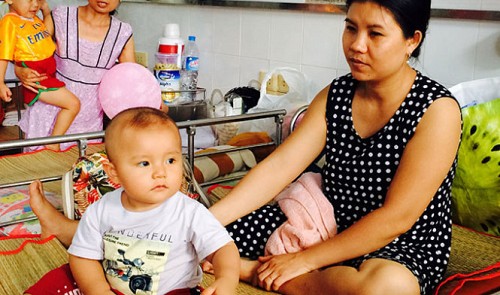Hand, foot and mouth disease spirals in Ho Chi Minh City

A total of 4,559 people, most of whom are children, were hospitalized in Ho Chi Minh City from early this year to September 4 for treatment for HFMD, which means 100-150 cases per week, the municipal Preventive Health Center said.
In the week from August 28 to September 4, the number of hospitalized patients soared to 191, or 32 percent higher than the average of the four previous weeks, the center added.
Dr. Pham Ngoc Thach, deputy head of the General Planning Department of Children’s Hospital 2, said the infirmary received 1,237 HFMD patients from early this year to September 9.
The hospital, located in District 1, treated 242 HFMD cases in August, which is nearly double the 126 cases in July, Dr. Thach said.
As many as 131 children were taken to the hospital due to the disease during the first nine days of September, the doctor elaborated.
Children’s Hospital 1 in District 10 is in the same situation, for the number of HFMD patients has sharply increased since last month.
Fifty-six children were being treated at the hospital on Thursday, much higher than the 20-30 cases per day in the previous month, Tuoi Tre(Youth) newspaper correspondents reported.
Dr. Truong Huu Khanh, head of the hospital’s infectious disease department, said that two weeks ago the number of HFMD patients was only 30-40 people, but the figure has risen to over 80 per day for the past several days.
HFMD can happen around the year, but it usually peaks in the March-May and September-November periods yearly, Dr. Khanh said.
The illness is characterized by a fever and rash most frequently seen on the palms, soles, and inside the mouth, the Vietnamese health ministry said.
The disease can be transmitted through digestive tracts and children under five years old are most vulnerable, the ministry said.
As there are no vaccines or specific medicines to cure the disease, the main preventive measure is following hygienic practices in eating, drinking, and living, the ministry advised.
What the stars mean:
★ Poor ★ ★ Promising ★★★ Good ★★★★ Very good ★★★★★ Exceptional
Latest News
More News
- Sun Life Vietnam contributes over $73,000 to support communities hit by Typhoon Yagi (September 21, 2024 | 10:12)
- Joint initiative promotes food safety at traditional markets in Hanoi (September 20, 2024 | 12:40)
- AEON Group donates nearly $105,000 to support people affected by Typhoon Yagi (September 20, 2024 | 08:43)
- Government resolution to support recovery after Typhoon Yagi (September 20, 2024 | 08:41)
- SLP Vietnam joins hands to support recovery from Typhoon Yagi (September 19, 2024 | 16:52)
- EU releases €650,000 in emergency aid to help victims of Typhoon Yagi in Vietnam (September 19, 2024 | 16:32)
- Haiphong picks itself up after typhoon (September 19, 2024 | 15:10)
- Hanoi endures widespread impact from Typhoon Yagi (September 19, 2024 | 15:02)
- Quang Ninh faces $960 million economic hit after Typhoon Yagi (September 17, 2024 | 18:05)
- Businesses are adapt to Vietnam's demographic shifts (September 17, 2024 | 17:43)



















 Mobile Version
Mobile Version